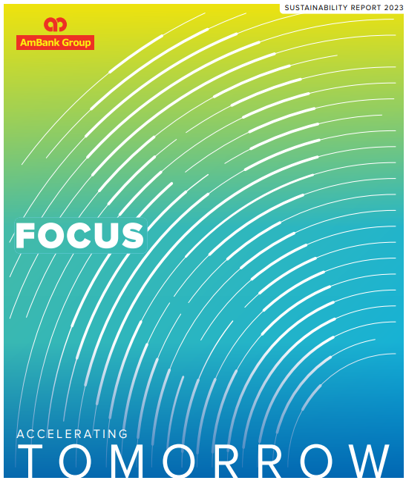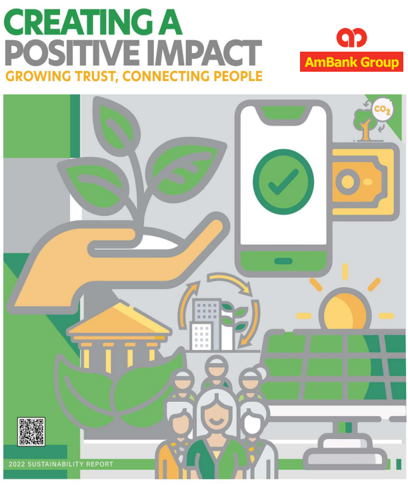










| Board-level Oversight | AmBank Group’s climate oversight is led by the Board of Directors and the Board Risk Management Committee (RMC), with sustainability and climate matters placed as a standing agenda item. The Board reviews the Group’s sustainability strategy and oversees the execution and integration of sustainability-related risks and opportunities. The annual Board effectiveness evaluation exercise also included the Board’s effectiveness in overseeing the sustainability-related matters. |
| Management-level Responsibilities | Chaired by the Group CEO, the management-level committees such as the Group Management Risk Committee (GMRC) and the Group Management Committee (GMC) look into matters related to sustainability risks and opportunities respectively, and the associated frameworks, policies and proposals. The Group Sustainability & Climate Risk Council (GSCRC) develops and implements sustainability-related strategies, as well as recommends sustainability performance indicators into the scorecards of Senior Management, including tracking their progress. The Board and Management-level committees/ council receive key updates on sustainability matters. In FY2025, key topics discussed included Strategic Sustainability Initiatives, Regulatory Compliance and Progress including the results and deliverables for compliance to BNM’s Climate Risk Management & Scenario Analysis (CRMSA), and the approval of the Group’s Net Zero Transition Plan (NZTP) and Sustainable Finance Product (SFP) Framework, as well as discussions on the Sustainable, Transition and Green (STG) Financing Guideline. |
| Climate-related Renumeration | The performance evaluation of Senior Management is carried out annually to measure how they have performed their respective roles to promote accountability. Sustainability performance indicators are incorporated into Senior Management’s scorecards, that is reviewed and approved by the Group Board Nomination and Remuneration Committee (GNRC). |
To learn more about AmBank Group’s Climate Action (Governance), please refer to pages 22 to 31 of the Sustainability Report 2025.
| Identification of Risks and Opportunities | The Group evaluates a broad spectrum of factors in our business activities and operations, encompassing environmental issues, social aspects, and governance related concerns. As part of our environmental risk assessment, we explicitly consider climate-related risks. These risks are prioritised for their heightened potential to disrupt sectors and amplify financial exposure. In particular, we identify and assess both transition and physical risks. Understanding these transmission channels allows the Group to assess its financial impact, plan mitigation measures, and respond proactively to evolving risk landscapes. Climate-related opportunities are identified across products, themes and market segments, as well as select hard-to-abate sectors. This is pursued through sustainable product innovation and early engagement with customers within these sectors. |
| Business, Strategic and Financial Impact, including Risk Appetite | Sustainability is one of the three core pillars of the WT29 strategy. This is operationalised through a Group-wide Sustainability Strategy, anchored on five key focus areas, namely developing the NZTP, Climate Risk Management, Capability & Capacity Building, Customer Engagement & Stakeholder Advocacy, and Reporting & Disclosure. In FY2025, the Group developed its NZTP, further informing the risks and opportunities presented within the seven priority hard-to-abate sectors to support decarbonisation and transition. To effectively manage and implement our NZTP, we have further established 2030 near-term targets and position statements for Palm Oil, Thermal Coal Mining, Power Generation, Oil & Gas, Cement Manufacturing, Iron & Steel and Commercial Real Estate – and operationalised through Group-wide credit policies and aligned with our risk appetite. The Group’s SFP Framework and STG Financing Guideline further support the development of green, sustainable, and transition finance products and service offerings and the integration of sustainability into capital allocation and financing strategies. |
| Scenario Analysis and Climate Resilience | The Group applies NGFS scenarios – Orderly, Disorderly, and Current Policies – across 30-year time horizons to assess physical and transition risks for the retail and non-retail portfolios. The key drivers to the forward looking metrics (i.e. Probability of Default (PD) and Loss Given Default (LGD) and ultimately the Expected Credit Loss (ECL), include physical and transition risk scores, forward-looking macroeconomic variables, sector specific sensitivities and geographic mapping. The insights from the scenario analysis help inform risk decisions and prioritise exposures across sectors, business segments, and product levels. |
To learn more about AmBank Group’s Climate Action (Strategy), please refer to pages 32 to 45 of the Sustainability Report 2025.
| Broader Risk Management Integration | Climate risks are systematically integrated into the Enterprise Risk Management (ERM) Framework and embedded within key internal policies, governance structures and sustainability strategies. This ensures that risk management serves as a strategic enabler to inform planning, strengthen resilience, and support sustainable value creation across the Group. Climate risks are embedded across the credit lifecycle – from screening and underwriting to monitoring and restructuring – and linked to the Group’s Risk Appetite Framework, Climate Change and Principle-based Taxonomy (CCPT) classification, and regulatory reporting. This is reflected as part of the lines of defence model of which sustainability is embedded into day-to-day operations and risk control functions. |
| Identification and Assessment Process | Climate risks are assessed through three key components, namely Group’s Climate Change and ESG Risk Assessment (CERA), Scenario Analysis and Stress Testing. These components integrate ESG considerations to support targeted decision-making across financing and investment portfolios. The CERA employs a combination of transactional and customer-level assessments to evaluate potential ESG risks for non-individual customers and financial investments as part of the credit decision-making process, with an ESG Risk Rating assigned for exposures of RM10 million and above. Transactions identified with elevated ESG risk are deliberated at the Credit and Commitment Committee (CACC). For AmFunds and AmIslamic Funds, the ESG assessment is part of the investment process, from screening, assessment, portfolio construction, continuous surveillance, to decision-making and engagement. ESG risks and opportunities are identified and assessed at company and sector levels. The proprietary ESG scores serve as an important indicator in identifying companies that are comparatively more sustainable, while facilitating portfolio rebalancing of Sustainable and Responsible Investments (SRI)-qualified funds to meet the Security Commission’s two-thirds minimum asset allocation requirement. |
| Risk Management Controls | Climate controls are embedded into Group-wide frameworks and policies, which are designed to align with the evolving landscape and regulatory expectations, while improving decision-making and portfolio resilience. To effectively manage climate-related risks, the Group embeds targeted control measures across its portfolios, operations, and customer engagements. This includes the Prohibition List, quantitative climate Risk Appetite Statement and NZTP to manage the exposure to select hard-to-abate sectors, as well as targeted risk assessments on the operations through the Business Continuity Management Framework. Climate risk-related policies are regularly reviewed by GSCRC and GMRC |
To learn more about AmBank Group’s Climate Action (Risk Management), please refer to pages 46 to 57 of the Sustainability Report 2025.
| Financed Emissions | In FY2025, AmBank Group established its financed emissions baseline for both retail and non-retail portfolios as part of our commitment to Net Zero by 2050. The total financed emissions baseline, covers our commercial, retail, Islamic and investment banking businesses for our three main subsidiaries using the Partnership for Carbon Accounting Financials (PCAF) methodology.
Our hard-to-abate sectors We selected hard-to-abate sectors based on guidance from NZBA’s carbon-intensive classifications and further refined with reference to globally recognised emissions-intensive sectors, to develop the inaugural NZTP. To maximise the impact of our decarbonisation efforts, seven hard-to-abate sectors were prioritised based on their significance within our non-retail portfolio, as determined through the financed emissions calculation exercise. The sectors covered Palm Oil, Thermal Coal Mining, Power Generation, Oil & Gas, Cement Manufacturing, Iron & Steel Manufacturing, Commercial Real Estate. These sectors represent RM51.93 billion in outstanding financing and investments, accounting for 39% of the Group’s total non-retail portfolio (excluding financial services, trading and other services (hotels, gambling, casino, services, etc.)). The same hard-to-abate sectors contribute to 45% the Group’s total non-retail portfolio, underscoring the importance of targeted actions in these areas. | ||
| Enterprise Emissions | Scope 1 & 2 The Group set enterprise emissions targets under our Carbon Neutral 2030 goal (Scope 1 and Scope 2). The Group reports Scope 1, Scope 2, Scope 2 Net GHG Emissions and selected Scope 3 GHG emissions (Waste Generated in Operations, Business Travel and Employee Commuting). Our enterprise emissions are measured against a 2024 baseline. We recorded 3.3% increase in Scope 1 emissions, rising from 60 tCO2e in FY2024 to 62 tCO2e in FY2025 due to the inclusion of additional vehicles, refined emission factor for diesel cars, augmentation of the Group’s reporting boundary. We successfully reduced our Scope 2 GHG emissions by 1.2% from 16,576 tCO2e in FY2024 to 16,375 tCO2e in FY2025, with a Net Scope 2 GHG emissions of 5,849 tCO2e. This decline reflects the Group’s continued energy efficiency measures, progressive installation of renewable energy solutions across operations and the subscription of Green Energy Tariffs (GETs) and Renewable Energy Certificates (RECs).
Scope 3 We expanded the boundary of our emissions tracking of Scope 3, which now includes employee commuting, as well as waste directed to disposal. This enhancement reflects our commitment to improving completeness and accuracy of our emissions inventory in line with best practices. We monitor our enterprise emissions GHG performance metrics, such as energy intensity and RECs purchased, at the Group level. | ||
| Targets & Progress | We have committed to achieve Net Zero by 2050 for our financed emissions, which include near-term targets for each hard-to-abate sector and are covering a new target: Carbon Neutral by 2030 (Scope 1 and Scope 2) for our enterprise emissions. These targets were established based on science-based reference pathways, with alignment to the goal of the Paris Agreement to hold the increase in the global average temperature to well below 2°C above pre-industrial levels. Notably, we will be exiting all thermal coal mining exposures by 2030. Our efforts and progress in achieving these targets will be disclosed in our annual sustainability disclosures. As 2030 approaches, we will revisit these targets as reference pathways are realigned and restated, technological innovation progresses with continuous improvements and learning in line with industry developments, science, technologies and best practices, and as more accurate information/ data is obtained.
|
To learn more about AmBank Group’s Climate Action (Metrics & Targets), please refer to pages 58 to 67 of the Sustainability Report 2025.